[This post, originally created on January 24, 2021, has been updated: New stuff here includes: 1) A photo and map of the area encompassing the Dutch cities of Meppel and Hoogeveen, and, the nearby Dwingelderveld National Park and Holtingerveld Nature Reserve (both northwest of Hoogeveen) and boswachterij Ruinen (forest district of Ruinen) – all in the province of Drenthe. I think (I cannot prove, but I think…) that one of these three areas is the likely locality where Major Milton Joel and the “flying wolf” crashed when shot down by pursuing Me-109Gs of III./JG 1; 2) Aerial images of the Dwingelderveld National Park and Holtingerveld Nature Reserve; 3) A little more information about the first American Jewish aviator captured by the Germans in WW II, 2 Lt. Irving Biers; and, 4) Mention of Pilot Officer Julius V. Silverston (79220), probably the first Jewish Commonwealth aviator to have been taken captive by the Germans during that war.]
Part IX: The Major, Still Missing
The Missing, Mentioned
On Monday, the 29th of November, 1943, the 8th Air Force lost seven P-38 Lightnings during a bomber escort mission to Bremen, Germany.
The pilots of these aircraft and the serial numbers of their planes (all P-38Hs) were:
77th Fighter Squadron, 20th Fighter Group
2 Lt. John Sherman Hascall – 42-67016, “LC * O“
38th Fighter Squadron, 55th Fighter Group
2 Lt. Albert Anthony Albino – 42-67051, “Spirit of Aberdeen“
2 Lt. John Joseph Carroll – 42-67090, “FOB Detroit“
2 Lt. James Michael Garvin – 42-67046
Major Milton Joel – 42-67020, “GA * A“, “flying wolf“
338th Fighter Squadron, 55th Fighter Group
2 Lt. Fleming William Suiter – 42-67069
343rd Fighter Squadron, 55th Fighter Group
2 Lt. James William Gilbride – 42-67097
Of these seven men, only two would return at the war’s end, both of whom survived as prisoners of war in Stalag Luft I, at Barth, Germany: Lieutenants Carroll and Suiter. Of the five who did not survive, four – Albino, Garvin, Gilbride, and Hascall (Gilbride and Hascall not survived parachuting from their planes) – would eventually be found, to eventually be buried in the United States, or in the case of Hascall, at the Netherlands American Cemetery and Memorial, in Margraten, Holland. You can read more about these men at this post, which covers the Army’s postwar effort to ascertain their fates, which in the case of Albino took over three decades: His remains were only recovered conclusively identified, and buried in 1978.
The fifth “MIA” – Major Joel – though definitely killed in action, has never been found. His probable fate is the subject of this post.
But, first … (!) … to continue with a feature of the prior posts in this story, here is an Oogle Map showing the general area where the 55th Fighter Group’s encounter with the Luftwaffe took place: the northern part of the Netherlands. The map shows the following: 1) The 55th Fighter Group’s intended and probable course into Germany (ironically, the 55th never actually reached Germany!), 2) The crash locations, as much as they can be pinpointed on this ultra-small-scale digital map, of all the above-listed pilots, except for a) Lt. Garvin (more about him below), and b) Major Joel. 2) The crash locations of three Me-109G-6s of the Seventh Staffel of Jagdgeschwader 1, lost (directly or indirectly) as a result of III./JG 1’s engagement with the 55th Fighter Group’s Lightnings on November 29, 3) The serial numbers of the lost P-38s and the three above-mentioned Me-109G-6s. Information about the three 7./JG 1 losses, and the crash locations of Lieutenants Carroll and Gilbride comes from Part 2 of Teunis Schuurman’s WW II – Research by PATS blog.]
 As before, maps symbols and colors indicate the following:
As before, maps symbols and colors indicate the following:
Bright blue line extending west to east across the Netherlands to a point near the Dutch-German border indicates the approximate or intended course of the 55th Fighter Group for a rendezvous with 8th Air Force bombers.
Black triangle shows the approximate area where the Luftwaffe initially assumed it would intercept the 55th Fighter Group’s P-38s, as explained in the book Jagdgeschwader 1 und 11: Einsatz in der Reichsverteidigung von 1939 bis 1945 (Jagdgeschwader 1 and 11: Used in the Defense of the Reich from 1939 to 1945).
Blue ovals with names adjacent indicate the last reported or assumed location of P-38 losses, based on information in Missing Air Crew Reports.
Red ovals with names adjacent indicate the actual locations where the P-38s were lost. Notice that there’s no blue oval for Lt. Hascall, because his P-38 was last sighted over the North Sea, at a point “west” of (to the left of) this map view, and Lieutenant Garvin, Major Joel’s wingman, because he definitely crashed at Hondschoote, France (again, well “off the map”). More information will be presented about Lt. Garvin’s fate in subsequent posts.
The location of Major Joel’s loss remains unknown. Some sources suggest the crash location was Marken Island in the Markermeer, indicated by a yellow oval.
In subsequent posts, I’ll discuss why I believe this location is incorrect.
Black ovals with names adjacent indicate the loss locations of three Me-109G-6s of 7/JG 1. (More about this below.)
________________________________________
Let’s start with a summary of the events of the mission, about which you can read in much more detail in the posts A Monday in November, A Battle in The Air, and, The Missing of November.
A Mission Summarized
The events of VIII Fighter Command Mission FO-192, the 55th Fighter Group’s bomber escort mission to Bremen are discussed in detail in the posts listed above, so here is a summary of the events of that day:
The 55th Fighter Group departs for Germany…
The 55th Fighter Group, comprised of three squadrons (38th, 338th, and 343rd) totaling forty-two planes, accompanied by ten Lightnings from the 20th Fighter Group, departs Nuthampstead, England, to escort B-17 Flying Fortress bombers on a mission to Bremen, Germany. The 38th Fighter Squadron, led by Major Joel, leads, followed by the 338th and lastly 343rd Fighter Squadrons.
The 38th and 338th Fighter Squadrons are depleted by over half their strength…
Though the force begins the mission with a total of fifty-two fighters, the strength of both the 38th and 338th Squadrons is soon depleted as aircraft from both squadrons (and at least two fighters from the 343rd) return to England. The 38th is diminished to a strength nine planes, the 338th to eight, and the 343rd at least to twelve.
The three squadrons enter Dutch airspace, intending to meet and escort the bomber force into Northern Germany. Major Joel, now in command of eight P-38s, starts to reform his Squadron into two flights of four aircraft.
The Luftwaffe intercepts the 38th and 338th Fighter Squadrons…
Here, events take a turn for the worse: The Luftwaffe intercepts the 38th and 338th Fighter Squadrons, the former bearing the brunt of the attack.
At a location probably over the Dutch city of Borger (about halfway between the cities of Assen and Emmen) the 38th and 338th Fighter Squadrons are intercepted by Me-109G-6 fighter of III./JG 1, a Luftwaffe Gruppen (Group) / Jagdgeschwader (Fighter Wing) based at Volkel. The attack commences at approximately 1415 local time. The 38th is attacked from a higher altitude, both out of the east – “out of the sun” – and from the rear.
The 38th Fighter Squadron confronts the attack…
Major Joel orders a right “break” into the German attack. A moment later, 1 Lt. Wilton E. Wyche calls a left break as more German fighters approaching from behind. Whatever semblance of a formation that had been formed a moment before is mostly disrupted: Major Joel and his wingman, Lt. James M. Garvin are separated, and Lt. Wyche spins out of the formation, recovering below.
From the moment of the German attack, Major Joel, Capt. Jerry Ayers, and possibly other pilots make repeated calls for help from the 338th and 343rd Fighter Squadrons.
Major Joel and Lt. John J. Carroll “form-up” as element leader and wingman. They are followed and given cover by Captain Jerry Ayers, who is forced to break away after he himself comes under attack, during which Ayers shoots down the leader of a pair of Me-109s attacking Major Joel and Lt. Carroll.
Major Joel and Lieutenant Carroll fly in a westerly direction…
Major Joel and Lt. Carroll fly west. They cover each other from attack by German fighter by going into a defensive aerial maneuver known as the Thach Weave.
After their first “weave” pass-by, Lt. Carroll witnesses a P-38, aflame in one engine, trailing smoke and with part of its tail shot away, fall to earth. In a letter published in Double Nickel, Double Trouble in 1993, he surmises that plane’s pilot to have been either Lt. Albino or Lt. Garvin. He is proven to have been correct: The pilot was Lt. Albino in the Spirit of Aberdeen. With tremendous forces, the aircraft crashes into railroad tracks at the train station in Hoogeveen, Holland, to such a depth that it is only, finally excavated in 1978.
At the crest of their third “weave” pass-by, Lt. Carroll witnesses – at a point where Major Joel’s P-38 should appear in mid-air – a Lightning “seemingly to disintegrate”.
A moment later, Lt. Carroll comes under attack. His right engine burning and his instrument panel damaged, the plane is still controllable. He rolls over and goes into a vertical dive to escape pursuing Me-109s. Recovering below, he sets course for England using his magnetic compass. But, the damage is too severe: he is forced to parachute from his plane, FOB Detroit, south of Meppel, and is captured very soon after landing.
Meanwhile, in the 343rd Fighter Squadron…
From the vantage point of the 343rd Fighter Squadron, Captain Rufus C. Franklin, Jr., (temporarily assigned from the 79th Fighter Squadron, 20th Fighter Group) notes that many enemy planes are seen to be approaching from a lower altitude in the “target area”. Group Commander Colonel Frank B. James starts a turn to meet the German planes, but then, the group (the nature of the “group” is unspecified) instead goes into a Lufbery Circle.
Captain Franklin and his Wingman, Lt. James M. Gilbride, occasionally “break out” from the “group” to see if another attack is imminent, with the “group” continuing in the Lufbery.
After two full 360-degree turns, the “group” heads back to England. Colonel James, no longer leading, returns to England alone.
As the “group” heads west, and later reported later by Captain Franklin and Lt. Erickson, Major Joel and Capt. Jerry Ayers are heard radioing for help.
When Captain Franklin and Lt. Gilbride are almost at the point of independently going back to help the beleaguered pilots of the 38th Fighter Squadron, the “group” of P-38s starts another turn, as if heading back to go to the aid of the 38th Fighter Squadron. But, the turn continues: The group again heads away from its brother squadron, the 38th’s engagement with the Me-109Gs of III./JG 1 still visible in the distance.
Capt. Franklin and Lt. Gilbride leave the 343rd and go to the aid of the 38th Fighter Squadron. “I could see the fight behind us as the Group made the turn and I broke out – Lt. Gilbride and I went back to help.” Their action saves the lives of three 38th Fighter Squadron pilots, and almost (but alas, not) a fourth.
After a flight of several minutes, element leader Captain Franklin and his wingman Lt. Gilbride reach the remnants of the 38th Fighter Squadron. They see five P-38s, each with one to three Me-109s on its tail. Just before they enter the gaggle of planes they witness a P-38 roll over and go down, its left engine burning, leaving a very heavy trail of black smoke, with an Me-109 directly behind. They have just witnessed the fall of Lt. Albino in the Spirit of Aberdeen, or, Lt. Carroll diving away in FOB Detroit.
The surprised German pilots roll and climb away from the two P-38s. Then, the four surviving 38th Fighter Squadron Lightnings head back to England, while Capt. Franklin and Lt. Gilbride make a 180-degree turn to join them.
Lieutenant Garvin vanishes…
One of the 38th Fighter Squadron P-38s “runs away” from the little group, its pilot then unidentified. He will turn out to have been Lt. Garvin, Major Joel’s wingman.
Lieutenant Gilbride is shot down…
The remaining five P-38s are closely followed by several pilots of III./JG 1, who at first attempt to lure the Lightnings into turning back and attacking. The American pilots refuse to take the “bait”, until the Me-109s finally pull up abreast of Captain Franklin, and Lieutenants Erickson and Gilbride, who “break” into the Messerschmitts. Captain Franklin loses an engine, but maintains control of his plane and stays with the other P-38s. After the P-38s have completed their turn, Lt. Gilbride vanishes somewhere over the area between Meppel and Hoogeveen. Uninjured, he escapes from his Lightning, but is killed when his parachute fails.
During the brief engagement, Captain Thomas E. Beaird, Jr., and Lt. Robert E. Erickson fire at and observe hits on two of the pursuing Me-109s, with the implication and possibility (albeit without any confirmation) that the German pilots were injured or killed by strikes on or near their canopies, their planes thus having been destroyed. However, under the circumstances, the eventual results of these two attacks cannot be confirmed, and neither pilot is credited with an aerial victory.
Captain Franklin and the three surviving 38th Fighter Squadron P-38s are pursued by Me-109s to the Dutch Coast.
Able to restart his engine and still pursued by Me-109s, Captain Franklin is rejoined by Lt. Erickson, the pair remaining abreast with the enemy planes following. The German fighters remain behind the P-38s until just beyond the Dutch coast. Then, they leave.
The four P-38s – Captains Franklin, Ayers, and Beaird, and Lt. Erickson – return to Nuthampstead.
The mission is over.
________________________________________
So, what of Major Joel?
Major Joel remains the only Lightning pilot still missing from the mission of November 29, 1943. He has not been seen since – first – Captain Jerry Ayers attempted to provide him cover from the attacking Me-109s of III./JG 1, and – second – when Lt. John Carroll fleetingly witnessed what was presumably the “flying wolf’s” destruction (shortly after Lt. Albino was shot down) after he and the Major had, unknowingly, at the time, flown over the northern part of the city of Hoogeveen.
Currently, four websites – “ZZ Air War”, “Back to Normandy”, the “Dutch Air War Study Group 1939-1945”, and Joe Baugher’s USAF Serials – have information pertaining to the probable crash location of Major Joel’s P-38. The first three are centered on the Ijsselmeer, in the northern and central section of the former Zuiderzee, and the latter on the Markermeer, in the southern section of what had been the Zuiderzee.
ZZ Air War has the following comment concerning Major Joel’s P-38: “Post war a P-38 Lightning wreck was recovered in the Lake near the Northeast-Polder dyke Aircraft was not identified and no human remains were found, but it could have been Major Joel’s aircraft, based on elimination, the crash position of the other P-38s in the area (Meppel) and the description of the dogfight.”
Back to Normandy parallels the above: “At the date of 29-11-1943, time: 1400, the aircraft type P-38 has been lost. The location of the plane was found at: Ijsselmeer. The unit of crew and plane is: 55FG/38FS. First flyer rank: Maj., name: M. Joel. The plane belonged to the Allied forces.”
The record for P-38H 42-67020 at the Dutch Air War Studygroup (Studiegroep Luchtoorlog 1939-1945) based on Verliesregister 1939-1945 (page 86), and a Casualty Report in SGLO Bulletin 218/16-17 states: “Damaged in combat with German fighters. Crashed Ijsselmeer.”
The main “take-away” of these three records is that this unidentified P-38 is considered to have been Major Joel’s plane through a process of elimination, the crash site locations of all other P-38s lost on November 29, 1943 having already been established.
The ijsselmeer is shown in the Oogle map below:
Joe Baugher’s website has a record stating that Major Joel’s Lightning fell at “Ijsselmeer Marken near Island” in the Markermeer, which is in the southern part of what was the Zuiderzee. The Major’s loss is attributed to Obergefreiter Wilhelm Krauter of 7./JG 1, possibly based on details about Krauter at the Kracker Luftwaffe Archive, where among his seven listed victories is recorded, “His 2nd [victory], a P-38 S of Ijsselmeer on 29 November, 1943.” As explained elsewhere, I don’t believe this is correct. Krauter probably pursued, fired at, and thus mistakenly believed he shot down Lt. James Garvin as the latter flew west-southwest towards France. As explained below, the “flying wolf” was almost certainly nowhere near Marken Island when it was shot down.
In any event, the most definitive way to verify the identity of the Marken Island Lightning (if that aircraft actually was a P-38) would be via ordnance or engine serial numbers, this be dependent on accessing these components in the first place. The question being, does anything, anywhere, in any condition, still exist of the wreckage of that supposed Lighting after nearly eight decades? Well… Probably not.
Marken Island is shown in the Oogle map below:
What do German records state? (Well, do they even state anything at all?)
The Luftgaukommando Reports listed in the Memorandum of May 2, 1949, pertaining to the search for Lt. Albino (the Memorandum is part of Major Joel’s Individual Deceased Personnel File) are the following:
Lt. Carroll: J 302: No location given
Lt. Garvin: J 338 / AV 513/44: Handschoote – Pas de Calais
Lt. Gilbride: AV 414/44: Meppel – Hoogeveen Raiload, near Koekange
Lt. Hascall: J 304 / AV 414/44: Wanneparveen (Oberuezel)
Lt. Suiter: J 305: No location given
Lightning Plane: J 307: Holland (pilot’s name not listed)
Oddly, only the Luftgaukommando Reports for Lieutenants Gilbride and Hascall appear in NARA’s chronological list of Luftgaukommando Reports. The list of these documents, part of Records Group 242, is chronologically arranged and spans late 1942 through March of 1945. A section of the list, encompassing reports filed for American planes lost from November 28 through November 30, appears below.
As you can see, Luftgaukommando Reports J 302, J 305, J 307, and J 338 are entirely absent (? – !) from the list, and, there’s absolutely no information about 8th Air Force P-47 losses that day. Another inconsistency: Luftgaukommando Report AV 414/44 and 424/44 is listed for Gilbride and Hascall, but AV 424/44 is not mentioned in the 1949 Memorandum.
So, here’s the NARA list:
To verify if a Luftgaukommando Report was even filed for Major Joel in the first place, the answers might – at first – be assumed be found among the Luftgaukommando Reports in NARA’s Records Group 242.
But, there are two problems with that. One big, and the other bigger.
The big problem? NARA’s holdings of Luftgaukommando Reports are incomplete. From my research at NARA, I recall that most / all the “low-numbered” J reports, from the supposed “J-1” through roughly J-500-ish range are missing. Perhaps these documents were lost or destroyed during the war, or if they survived, never became part of NARA’s holdings.
The bigger problem? NARA is presently closed to researchers. (Oh, well.)
Another explanation: Major Joel crashed in neither the Ijsselmeer nor the Markermeer, but upon the mainland of Holland, where plane and pilot remain today, at a point unknown.
By following and considering the course of the 55th Fighter Group’s engagement with III./JG 1, a different explanation emerges to explain why Major Joel has never been found.
First, from the perspectives of both the 38th Fighter Squadron, and Captain Franklin and Lt. Gilbride of the 343rd Fighter Squadron, the air battle eventually proceeded in a generally westerly direction, passing west from Borger to Hoogeveen and Meppel, with Captains Franklin, Ayers, Beaird, and Lt. Erickson eventually heading back to England by flying west over the Ijsselmeer.
Second, among the six P-38s that were shot down, four were lost, sequentially, one after another, along the same westward direction. The “timing” of the losses of the other two P-38s – flown Lt. Hascall and Lt. Suiter – is unknown.
The four P-38s were shot down in the order listed below:
1st: Lt. Albino (In the northern part of the city of Hoogeveen.)
2nd: Major Joel (Disintegrated and / or vanished in mid-air.)
3rd: Lt. Carroll (Near the farm community of Zwartewatersklooster, just outside of Zwartsluis.)
4th: Lt. Gilbride (In Koekange near the Emsweg; formerly the municipality of De Wijk. The aircraft crashed in the Oosterboer – location Binnenweg.)
The three III./JG 1 Me-109Gs lost in the engagement with the P-38s, those of Oberfeldwebel Hermann Brackhagen, Oberleutnant Heinrich Klöpper, and Oberfahnrich Manfred Spork – whether from combat or bad weather – all crashed further west than Carroll and Gilbride: in an area about 4 miles west-southwest of Meppel, between the Zwarte Meer and the Weeribben-Wieden National Park.
The crash locations of these American and German aircraft are shown below:
Third, John Carroll’s postwar account of the battle in Double Nickel, Double Trouble was remarkably accurate despite the passage of fifty years. His recollection of the loss of Lt. Albino, one engine aflame and falling to earth, matched accounts of Lt. Albino’s loss as viewed by civilians in Hoogeveen. And so, given that John Carroll’s recollection of Lt. Albino’s loss was valid, then just as much for his last sight of the “flying wolf”: “At the crest of my turn I glanced across the projected pattern and observed what should be Joel’s A/C seemingly to disintegrate.”
But, what could possibly have caused an aircraft as large as a P-38, a twin-engine aircraft with a wingspan of over fifty feet and a length of nearly forty, to disintegrate in mid-air? I think the answer is simple, and lies in the very armament of the G-6/U4 version of the Messerschmitt Me-109.
As presented in the Wikipedia entry covering “Messerschmitt Bf 109 variants“, “The G-6/U4 variant was armed with a 30 mm (1.18 in) MK 108 cannon mounted as a Motorkanone firing through the propeller hub instead of the 20 mm MG 151/20.” The MK 108 cannon fired a 330 gram (total weight) high-explosive shell “(a “self-destroying tracer (“M-Shell” or “Mine-Shell”)” of such great power that four or five hits could destroy a B-17 [Flying Fortress] or B-24 [Liberator], while one shell alone could, in theory, destroy a fighter plane. (The information about the M-Shell comes from Wikipedia and Luft46 entries for the MK 108 / Rheinmetall Borsig MK 108 30mm cannon. The original reference is unknown.)
And then, “flying wolf”, whether intact or otherwise, fell to earth from an altitude of approximately thirty thousand feet. But, where did it land?
The fact that the plane was downed after Lt. Albino’s loss; while the Major and Lt. Carroll were in the midst of their third Thach Weave, and just before Lt. Carroll came under attack and dove vertically to escape his pursuers, places the general location of Major Joel’s loss somewhere between the locations where the Spirit of Aberdeen and FOB Detroit crashed.
So, correlating time and space yields a location somewhere between the Hoogeveen railroad station (Albino) and Zwartewatersklooster, southwest of Meppel (Carroll).
But, why was nothing ever reported by Dutch civilians or the German military?
Air photos and map views reveal that most of the land surrounding Hoogeveen and Meppel is used for agricultural purposes, and thus devoid of native tree growth and, with (I think?) relatively flat topography. If the “flying wolf” or any aircraft had fallen upon this sort of terrain, certainly its wreckage would have been recognized. If not immediately, then very soon after.
But, this area of Holland is characterized not only by agricultural use, and, cities and smaller towns. Near Hoogeveen and Meppel are the Dwingelderveld National Park and Holtingerveld Nature Reserve (both northwest of Hoogeveen) and the boswachterij Ruinen (forest district of Ruinen) – all in the province of Drenthe – and to the west of Meppel lies the Werribben-Wieden National Park, in the province of Overijssel.
____________________
This Apple Map image from Duck-Duck-Go shows Meppel (bottom left) and Hoogeveen (lower right), with the Holtingerveld Nature Reserve and Dwingelderveld National Park at left and right in the upper center, respectively, with the boswachterij Ruinen just west of Hoogeveen. Note that the nature reserve and national park appear as darker shades of green, agricultural land in medium and lighter shades of green, and Meppel and Hoogeveen in kind-of-gray(ish).
Here’s a street view of the above map. Parks and nature reserves appear in medium green, while agricultural land land is in pale greenish-tan.
____________________
This Oogle Earth image shows the Holtingerveld Nature Reserve…
Here’s the same Ooglicious image, without the distraction of labels.
____________________
…and this Oogle Earth image shows the Dwingelderveld National Park.
Here’s the same Ooglish Earthish image, again sans labels.
____________________
Though the exact heading that Major Joel and Lt. Carroll had taken will forever remain unknown, I believe – I can’t prove, but I think – the most likely scenario was that the Major’s P-38 was shot down over the boswachterij Ruinen (forest district of Ruinen), which (?) takes its name from a village by that name situated northwest of Hoogeveen.
(Albeit it’s also possible that Major Joel crashed into either the Dwingelderveld National Park or Holtingerveld Nature Reserve.)
In any case, Map Carta, Oogle Earth, and other imagery reveal the boswachterij Ruinen to be (from what I can tell!) a mixture of forest and heathlands.
Here’s a closer Oogle Earth view of the boswachterij Ruinen, with geographic features labeled:
The same view as above, sans labels:
From the YouTube channel of Ria Kroes, this video (from 2012) gives an informative view of scenery and nature in the boswachterij Ruinen. It’s as nicely symbolic as it is ironic that the video concludes with a view of the sky…
Video caption:
Dutch:
Title: “stilte en vogels boswachterij ruinen“
Description: “Verre reizen zijn mooi, maar ook in eigen land is veel meer te beleven dan wel eens gedacht wordt. Op zomaar een zaterdag wandelden we in de zon en tussen de vogelgeluiden door de boswachterij ruinen in echten, drenthe. We volgden dit keer een deel van het familiepad en de groene route.”
English translation:
Title: Silence and birds in the boswachterij ruinen.
Description: Long journeys are beautiful, but there is much more to experience in your own country than is sometimes thought. On just any Saturday we walked in the sun between bird songs through the forest district of Ruinen in Echten – Drenthe. [Echten, Hoogeveen, Assen, and Borger are all located in the province of Drenthe.] This time we followed part of the family path and the green route.”
From Map Carta, this image shows the boswachterij ruinen in relation to Hoogeveen. Immediately obvious is the size of the area, approximately the same as that of Hoogeveen itself.
Summarizing, these are the two scenarios for Major Joel’s disappearance:
1) The “flying wolf” actually did crash in the east-central part of the Ijsselmeer, or, on Marken Island.
2) The aircraft crashed somewhere in an uninhabited in the vicinity of Hoogeveen, the most likely locality – given the loss of Lt. Albino moments before and Lt. Carroll shortly after – in the boswachterij Ruinen. If this is so, perhaps the “flying wolf” impacted as deeply as Lt. Albino’s Spirit of Aberdeen (which even in 1943 was already at a depth of six meters), albeit in forest, heath, or swamp. As described at natuurgebieden/ruinen, “Tot ruim zeventig jaar geleden was de omgeving van Ruinen ‘woest en ledig’. Onontgonnen en vaak ontoegankelijk land met veen, zand en uitgestrekte heidevelden.” Or: “Until more than seventy years ago, the area around Ruinen was ‘wild and empty’. Undeveloped and often inaccessible land with peat, sand and extensive heathlands.”
And so, akin to the proverbial question, “If a tree falls in a forest and nobody hears it, does it make a sound?”: “If a P-38 falls from an overcast sky and there is no-one to witness its plunge to earth, where has it fallen? Has it fallen?”
One last question…Did Major Joel escape from the “flying wolf” and parachute to earth?
I don’t believe so. I’ve come across no indications that Major Joel was taken prisoner.
Major Joel’s IDPF has no documents pertaining to this possibility except for the query in his father’s letter of October 3, 1946. He was never reported as having been interned in any POW camp. There are no Case Files in Records of the Judge Advocate General’s Office (National Archives Records Group 153) about him. There is no record of him in the Luftgaukommando Report name index, or, the chronological loss list of Luftgaukommando Reports. The only other possibility in terms of Luftgaukommando Reports would be a J-Report in the low 300-range for any hypothetical unknown flier – an “unbekannter Flieger” – but as mentioned above, J-Reports in that numerical range don’t even exist in NARA’s holdings.
Paralleling that scenario, there was by this time – late 1943 – nothing altogether unprecedented in the capture and internment as POWs of Jewish aviators from the United States Army Air Force, let alone the French Armée de l’Air or British Commonwealth Air Forces, by the German military. (As for the fate of Jewish POWs from the armed forces of Poland or the Soviet Union, let alone the Axis treatment of Soviet POWs “in general”? Well, in comparison with German treatment of POWS of the Western Allies, Germany’s war in the “East” was enormously different in ideology, intent, and scope than that waged against the “West”.)
Specifically, the first Jewish aviator captured by the Germans in the Second World War was Lieutenant Jean Israël, an observer in GR II / 33 Savoie of the Armée de l’Air. A crewman in a Potez 637-A3 piloted by Adjutant Guerin, his aircraft was shot down on May 22, 1940, with the all three crewmen parachuting to safety. Born in 1913, Israël spent five years as a POW in Oflag IVD (Elsterhorst), postwar becoming a Colonel in the French Air Force and a chief pilot of Air Algérie. He was specifically mentioned by Antoine de Saint Exupery in the book Flight to Arras. You can view the cover of a paperback edition here.
____________________
Prior to November 29, 1943, about 140 American and over 30 Commonwealth Jewish aviators had been captured by the Germans, most having been imprisoned at Stalag Luft I, Stalag Luft III, or Stalag XVIIB. (Many more would follow.)
In the British Commonwealth Air Forces, Pilot Officer Julius V. Silverston (79220), an air gunner in No. 61 Squadron Royal Air Force, was captured during a night mission to Stettin on the evening of September 5-6, 1940, and imprisoned at Stalag Luft III. His entire crew of four, in Hampden I P4350 (piloted by F/ Lt. J.D. Haskins) survived with him. Mentioned in The Jewish Chronicle on September 27 of that year, his father was Bertram Silverstone, of Manor Road, in Edgbaston, Birmingham. I believe he was the first Jewish Commonwealth aviator to have been taken captive by the Germans during WW II.
In terms of the United States Army Air Force, the first Jewish aviator to have been captured by the Germans was 2 Lt. Irving Biers, a co-pilot in the 83rd Bomb Squadron of the 12th (“Earthquakers”) Bomb Group, taken prisoner in North Africa on September 1, 1942. In the image below, published in Life Magazine on May 31, 1943, Lt. Biers is second from right at the bottom of the photo, wearing both moustache and gloves.
The caption beneath the photo reads:
“Captured American fliers pose for a snapshot in a prison camp somewhere in Gemany. Second Lieut. A.L. Graham Jr. of the Air Forces, who was shot down over Europe on Nov. 9, 1942, sent this picture to his mother, Mrs. Pearl Graham of Floyd, Va., stitched to the inside of a letter. Graham sits third from left with his back against a building. His letter, dated January 19, follows: ‘Dear Mother, Just a few lines to let you know I am well and getting along fine. Attached to this letter is a picture of a group of us Americans taken outside of our barracks. I am learning to ice skate on an ice-skating rink we have fixed up inside our compound. Ice skating, attending a few lectures, and sleeping, just about dominated our time here in camp. Mama, is my allotment still coming in every month? If so, how much do I have in the bank now? You can send a food parcel every three weeks; send such things as oatmeal, cocoa, chocolate bars, tinned meat and stuff to make puddings. In clothing parcel send me a pair of pants, shirt, socks, undershirts and shorts, toothpaste and brush. Contact the post office and they will give you information on sending parcels. Love, A.L. Graham Jr, 2nd Lt. U.S.A.A.F.’ As officer-prisoners, Lieut. Graham and companions cannot be required to work under international law.”
(2 Lt. Andrew L. Graham, Jr. (0-726152) was the bombardier of B-17F 41-24491 of the 423rd Bomb Squadron, 306th Bomb Group.)
The image below shows biographical entries for Lt. Biers and his pilot, Captain Hubert P. Croteau, in Arnold A. Wright’s 1993 book Behind The Wire – Stalag Luft III South Compound. This creation of this massive book is a story unto itself, for it is a transcription of over 2,190 biographical entries of POWs compiled by 2 Lt. Ewell Ross McCright during his imprisonment in Stalag Luft III. McCright’s endeavor – suggested to him by Lt. Col. Albert P. Clark, Jr. – was of great help in compiling and preserving military records, and simultaneously, of psychological and spiritual benefit in providing him with a long-term project combining intense intellectual focus and physical activity, an endeavor which revived his wounded spirit after the trauma of being shot down and losing of all but two of his nine fellow crew members.
The biographical entries in the Wright / McCright book, while succinct, comprise information of both military and genealogical nature, oftimes with brief comments about the circumstances of the POW’s capture, injuries, mistreatment upon capture (if that occurred), and statements about other POWs, casualties, or war crimes. The vast majority of the entries conclude with a line pertaining to the POW’s marital status (of course, the majority of these men were single), military awards, date of birth, and finally, a single letter indicating the man’s religion, indicated by the letters “P”, “C”, and, “H” or “J”. Like some other Jewish POWs listed in this book, Lt. Biers (who disposed of his dog-tags after landing by parachute in the Egyptian desert, as recorded at Roland Rakow’s Story – An Update), reported his religion as “P”.
You can read more about the loss of the Croteau crew, covered in MACR 16228, at Camp 59 Survivors.
And, the cover of Arnold Wright’s book…
(2 Lt. McCright (0-727112) was the bombardier of B-17F 41-24567 (“PU * J” / “Beats Me“) of the 360th Bomb Squadron, 303rd Bomb Group, lost on January 23, 1943. The plane’s pilot was 1 Lt. Joseph E. Haas. The plane’s loss is covered in MACR 15571.)
____________________
Prior to November 29, the highest ranking Jewish aviator captured by the Germans was Captain Leon B. Margolian of the 65th Fighter Squadron, 57th Fighter Group, who was shot down near Marble Arch, Libya, during a dogfight with Me-109s on December 10, 1942.
Captain Leon B. Margolian in his POW identification photograph. (c/o Leon B. Margolian)
____________________
On November 29, 1943, two American Jewish aviators (2 Lt. Morton David Breslau of the 548th Bomb Squadron, 385th Bomb Group, from B-17 Gremlin’s Buggy / GX * H, (B-17F 42-30204, piloted by 1 Lt. Richard Yoder; MACR 1581), and 2 Lt. Charles K. Hecht, Jr., of the 358th Fighter Squadron, 355th Fighter Group, who piloted Thunderbolt YF * U (P-47D 42-8631; MACR 1284) would be captured as well. The photo below shows Lieutenant Hecht seated in a razorback Thunderbolt at Steeple Morden. (c/o Charles K. Hecht, Jr.)
____________________
The primary difference between Major Joel and these men would have been his rank, level of command, and therefore his awareness of information associated with this position and its responsibilities. Certainly German military intelligence would by late 1943 have been aware through publicly available information – no more and no less than for any other American or British Commonwealth aviator – of his civilian and military biography, a topic that has been covered in many popular accounts of the experiences of USAAF aviators captured by the Germans.
On the other hand, an entirely hypothetical scenario – in which Major Joel had been captured but did not survive – would not necessarily have precluded his name from actually appearing in a Luftgaukommando Report. Based on an examination of many (many) Luftgaukommando Reports, and the Missing Air Crew Reports (well, except for post-war “fill in” MACRs), in instances where war crimes were committed against captured American airmen by German civilians or military personnel, the names of those airmen still appear (with some exceptions…) in relevant Luftgaukommando reports. Albeit, in such cases there is little to no (or euphemistic, at best…) information about their actual fates.
But again, there is no evidence that Major Joel survived to be captured. There is nothing indicating that he fell – fell allegorically; fell symbolically; fell literally – into German captivity.
He fell instead I believe, with his aircraft, entirely unseen by men.
________________________________________
A Star of Silver
By mid-1944, Major Joel had received the Silver Star, the citation for which follows:
“For gallantry in action, while leading a Squadron of P-38 aircraft as support for bombers on a mission over Germany, 29 November 1943. Before reaching the point of rendezvous, seven planes of his unit were forced to turn back due to mechanical failures, thus reducing the strength of his unit to nine planes. While reorganizing his unit, it was attacked by a superior number of hostile fighters. Major Joel quickly reformed his Squadron and engaged the enemy in a violent aerial battle. Because of a fast diminishing fuel supply, the group leader gave the signal to withdraw. As the group headed for base, the enemy continued to press vicious assaults on the tail aircraft. With disregard for his own safety, Major Joel attacked the enemy head-on, thus giving the other members of his unit time to withdraw. When last seen he was still engaged in combat with the enemy. The gallantry, aggressive fighting spirit and devotion to duty displayed by Major Joel reflect highest credit upon himself and the Armed Forces of the United States.”
Well, the text of the citation is inspiring.
For a wife and parents whose husband and son was then “Missing In Action”, the award doubtless provided some measure of compensation, however small, when weighed amidst the impact of their loss – as shown in Joseph Joel’s letter of October 3, 1946. But, it is my belief that – however well-written; however well-intended – the account presented in the citation, while not entirely false, is hardly entirely true.
The central problem with the citation arises from the statement about the 55th Fighter Group’s “fast diminishing fuel supply”, in light of the actions of Captain Rufus Franklin and Lieutenant James Gilbride. Rather than return to Nuthampstead in the (relative) safety of the 343rd (and 338th?) Squadron, the pair – alone; knowingly; intentionally, at Captain Franklin’s initiative – left the 343rd Fighter Squadron, flew east as an isolated pair for several minutes, and broke up III./JG 1’s attack upon the P-38s of Ayers, Beaird, and Erickson, and Garvin. During their return to England these pilots (excepting Garvin, who left the group, and Gilbride, who was shot down) flew west at maximum speed in an effort to escape the pursuing Me-109s.
It’s difficult to believe they would – and could – possibly have attempted any of these actions, given the speed, distance, and fuel consumption involved, had their fuel supply already been “fast-diminishing” before they left the main body of the 55th Fighter Group.
And… As mentioned by Captain Franklin – both Major Joel and Captain Ayers had been making radio calls for help from the 338th and 343rd throughout the German attack, until Capt. Franklin’s “arrival” with Lt. Gilbride.
And also… In Captain Franklin’s statements in the relevant Missing Air Crew Reports, there is absolutely no mention of a lack of fuel.
And as well… The citation gives the impression that Major Joel deliberately remained behind as the 55th Fighter Group headed towards England, flying directly into the face of the enemy to give the “group” time to escape. Well, certainly he, Lt. Garvin, and other pilots attempted to break into the attacking Me-109s, but this took place in the midst of reforming the greatly outnumbered 38th, rather than with the intention of making a proverbial “last stand”.
Perhaps the intent of the citation had far (far) more to do with symbolism than reality. Maybe it was a way to bestow a last honor on a pilot, officer, and military leader who General Kepner respected; to provide a measure of solace to that pilot’s anxious wife and parents; perhaps it was intended (and in this, it would have been but one example of many) as a symbol of inspiration and recognition of fighting spirit by the VIII Fighter Command during a time of great challenge and growth.
So, here’s a copy of Major Joel’s Silver Star citation, as part of the text of the War Department’s April 1948 letter to his father.

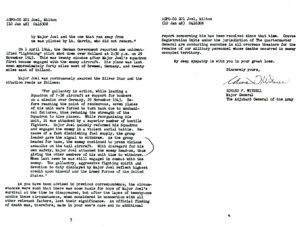 And, here’s a news item about the Major’s Silver Star award (as reported in the Richmond Times-Dispatch?).
And, here’s a news item about the Major’s Silver Star award (as reported in the Richmond Times-Dispatch?).
Missing Pilot Wins Silver Star Medal
For courageous and inspiring conduct in air combat over Europe, the Army today announced the award of the Silver Star medal to Maj. William Joel, of 153 S. Rodeo Dr., Beverly Hills.
Major Joel, who is reported missing in action, was cited for “gallantry, aggressive fighting spirit and devotion to duty” in protecting a depleted squadron of P-38 fighters savagely attacked over Germany Nov. 29 last year, according to Associated Press dispatches. “Because of a fast diminishing fuel supply,” the citation continued, “the group leader gave the signal to withdraw.
As the group headed for base, the enemy continued to press vicious assaults on the tail aircraft and with disregard for his own safety, he attacked the enemy head on. When last seen Major Joel was still engaged in combat.
–
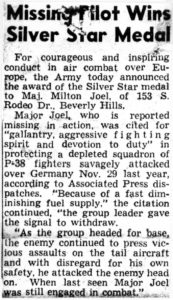 Next: Part X – Fragments of Memory
Next: Part X – Fragments of Memory








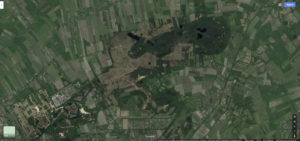
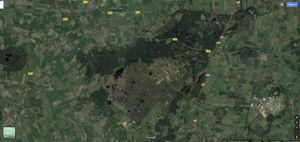
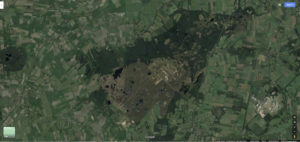




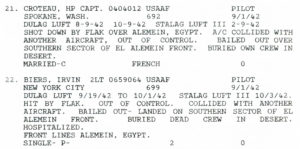
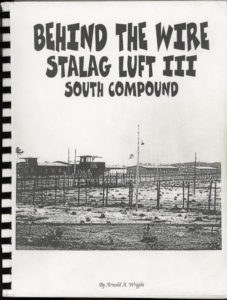
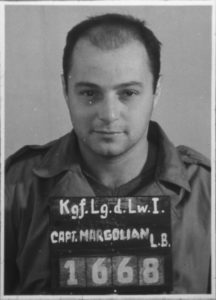

Can you please email me back? Leonard H Busch is my great uncle. Thank you.